
Original Link: https://www.anandtech.com/show/6479/nanoxia-deep-silence-1-case-review-you-asked-for-it-you-got-it
Nanoxia Deep Silence 1 Case Review: You Asked For It, You Got It
by Dustin Sklavos on November 27, 2012 12:01 AM EST- Posted in
- Cases/Cooling/PSUs
- quiet
- ATX
- Nanoxia
Introducing the Nanoxia Deep Silence 1
When I reviewed the BitFenix Ghost, some of you requested we take a look at the Nanoxia Deep Silence 1. Nanoxia isn't selling on American shores yet, but there's been a lot of buzz going around about this case, and Nanoxia has been steadily making inroads towards getting it into our hands. If you couldn't tell from the name, the Deep Silence 1 is designed for quiet, efficient running, and in many ways it looks like exactly the case I requested at the end of my review of the Ghost: same principles, just bigger and better.
As it turns out, Nanoxia wanted us to look at the Deep Silence 1 as well. I was initially reluctant as you can't actually buy it in the States yet, but hopefully this review will help change that. While the Deep Silence 1 isn't the grand slam some people make it out to be, it is very close, and demonstrates a real evolution in the way silent cases are designed. So what did this small German firm do with the Deep Silence 1 that makes it so different from other silent cases? A few things, as it turns out.
.jpg)
In my experience, cases engineered for silent running can oftentimes be chasing the wrong vectors. They're seldom bad cases, but acoustic padding can't make up for efficient airflow, and having to close off ventilation can actually cause more problems than it solves. It's entirely possible to produce a silent, well-ventilated case, but getting the design right means dodging a veritable minefield of decisions that will threaten to undermine your intended goal.
The result, thus far, has been that while cases like the BitFenix Ghost and Corsair Obsidian 550D aren't necessarily bad, with our testbed they've had to expend more effort on trying to smother the noise generated by high fan speeds rather than keeping the components cooler in the first place. Users interested in building a system designed to run quietly will have less trouble (they'll be more apt to use quieter-running parts), but the underlying issue persists, so the question is...was Nanoxia able to do the unthinkable and balance the equation?
| Nanoxia Deep Silence 1 Specifications | ||
| Motherboard Form Factor | Mini-ITX, Micro-ATX, ATX, XL-ATX | |
| Drive Bays | External | 3x 5.25" (plus included 5.25"-to-3.5" adapter plate) |
| Internal | 8x 2.5"/3.5" | |
| Cooling | Front | 2x 120mm intake fan |
| Rear | 1x 140mm exhaust fan (compatible with 120mm) | |
| Top | 2x 120mm/140mm fan mount | |
| Side | 1x 120mm/140mm fan mount | |
| Bottom | 1x 120mm/140mm fan mount | |
| Expansion Slots | 8 | |
| I/O Port | 2x USB 3.0, 2x USB 2.0, 1x Headphone, 1x Mic | |
| Power Supply Size | ATX | |
| Clearances | HSF | 185mm |
| PSU | 200mm | |
| GPU | 12.4" / 315mm | |
| Dimensions |
20.35" x 8.66" x 20.94" 517mm x 220mm x 532mm |
|
| Weight | 25 lbs / 11.34 kg | |
| Special Features |
Removable fan filters USB 3.0 via internal header Analog dual-channel fan controller (three fans per channel) Toggleable "chimney" Removable drive cages Acoustic padding on the doors and side panels |
|
| Price | 109 EUR; expected US MSRP between $109-$129 | |
Even just unboxing it, what struck me the most about the Deep Silence 1 is how heavy it is, and that was my first clue that it might be a bit better at its job than some of the other silent cases I've tested. It's appreciably heavier than both the BitFenix Ghost and the Corsair Obsidian 550D due to the use of both the acoustic padding and, frankly, a heavy steel frame. This is not a cheaply built case, and the thicker materials used in its construction should go a long way towards containing noise.
In and Around the Nanoxia Deep Silence 1
Producing a good case design doesn't necessarily mean strictly deviating from established convention in favor of something new, and what Nanoxia has done with the Deep Silence 1 is smartly integrate some of the better design choices from competitors alongside some innovations of their own. This case obviously wasn't developed in a vacuum, but as you'll see, the combination of design decisions is incredibly smart.
In terms of building materials, Nanoxia opted to use a combination of thick SECC steel and soft-touch-finished plastic (similar to what BitFenix enjoys). Unfortunately they weren't able to match tones quite as well as BitFenix tends to, but it's a minor complaint.
.jpg)
The front of the Deep Silence 1 is probably one of the most striking parts of the design. Silent enclosures traditionally feature doors, and BitFenix and Corsair opted to install doors that opened in either direction. Nanoxia's only open one way (hinged on the right side), but they actually split the door in two, with the top door handling access to the fan controller, reset button, and external bays while the bottom door hides the intake fans. To ensure the intakes are properly fed, Nanoxia also ventilated the sides of the fascia. Additionally, the intake fans themselves are on hinges, allowing you to easily pop them open and clean the dust filters. There are a lot of little things going on here but it adds up to a series of smart, practical descisions that nonetheless allow the case to maintain a very attractive face.
Keeping with that clean but functional design, the top of the case features the power button (interestingly, the power light which circles the power button glows green instead of blue) and two hidden features. The first is the port cluster, which is hinged and hidden away until it needs to be popped up and used. Even open, it doesn't really disturb the aesthetic. The other is Nanoxia's "chimney," which is mechanically raised and lowered by a switch on the left side. Nanoxia cites the chimney as being good for allowing excess heat to silently exit the case, but I found the claim specious and similar to how SilverStone claims the 90-degree motherboard rotation allows for heat to more efficiently be transferred outside of the case. SilverStone's 90-degree cases work because they have intake fans that blow directly on the hottest components; convection has virtually nothing to do with it. By the same token, I think the chimney is probably more appropriate for ventilating the top fan mounts when those mounts are occupied.
Side panels are held to the Deep Silence 1 by thumbscrews, and they slide in on unfortunately old-timey notches. This is something that could and should've been brought up to modern standards by using hinges to hold the panels in place. When you do get inside the DS1, though, you'll find a design that's an excellent refinement of existing case design conventions.
.jpg)
There are a grand total of three drive cages, two of which are removable, and you can mount one to the bottom of the case (above the intake mount) or remove that mounting entirely to install another fan. If you remove both cages you're still left with three drive sleds, which for many users should be more than adequate, and this leaves one of the intake fans completely unblocked. Nanoxia also includes toolless locking mechanisms for the 5.25" drive bays, and better still, they've included routing holes in the motherboard tray not just for ATX boards, but for Micro-ATX as well. It's actually a really smart decision; if the end user is using a smaller board they can still keep things clean, while larger boards simply block the unneeded holes.
Finally, I'd like to point out that Nanoxia includes a wealth of conveniences in the package for the DS1, including an extension cable for the AUX 12V line, an adaptor tray and shield for one of the 5.25" drive bays to allow installing a 3.5" external peripheral, and even grommets to completely block the liquid cooling routing holes in the back of the enclosure. There's also a healthy amount of space inside for installing radiators to the top, back, and bottom, and the DS1 is one of the only cases I've seen that supports 140mm/280mm radiators.
Assembling the Nanoxia Deep Silence 1
While Nanoxia's Deep Silence 1 has a fairly smart layout and is reasonably convenient, there are were still a couple of hangups when I went to assemble our testbed inside it. There weren't any major issues, just a series of small annoyances.
The motherboard went in easy enough, but I would've appreciated a center-mounted guide post similar to how I've seen in recent cases (including BitFenix's Ghost), and I had an unusually difficult time getting the motherboard's I/O shield to snap into place. Routing case headers to the motherboard was also mostly easy, but there's nothing inside the DS1 that keeps the cables from slipping into the optical drive bays; you pretty much have to have an optical drive installed to keep that clean. Depending on how you route the cables and if you removed the top panel at any point, you may also find that the I/O hinge at the top of the case actually sticks. Nanoxia says they've already solved the problem, so hopefully if the DS1 gets to retail in the United States end users won't run into it.
.jpg)
Installing the optical drive and SSD was pain free. Toolless installation of the optical drive was easy and Nanoxia smartly includes toolless clamps on both sides of the drive; better still, the drive bay shields are similar to the snap-in ones that NZXT uses, which feature a locking lever. The drive sleds themselves are durable metal with rubber vibration grommets for 3.5" drives, but they're not toolless; both 2.5" and 3.5" drives need to be screwed into place. Thankfully the sleds themselves fit securely into the drive cages.
Getting the power supply in, on the other hand, proved to be more challenging than it needed to be. Nanoxia features two rubber studs that hold up the back of ther power supply, but there's no guide for the front of it, causing it to easily dip and thus requiring some Arm Fu to get the PSU lined up and screwed into place. This could've been avoided by just putting a slight lip inside the case to hold up the front.
.jpg)
The graphics card was also difficult. I'm used to having to bow either the bracket or the case to get everything to line up, but the DS1 required more force than I expected. This can be kind of a crap shoot, but it feels like the measurements here were ever so slightly off.
.jpg)
Thankfully, getting everything wired together was fairly easy apart from two minor complaints. The routing holes in the motherboard tray are all very intelligently aligned and spacious enough, and the grommets themselves stay securely in place. My only issues were the aggravatingly small hole for routing the AUX 12V line above the motherboard tray where I accidentally snapped one of the clamps after it got caught on a rivet, and the use of a molex connector for the fan controller instead of a SATA power connector.
Finally putting the side panels back on wound up being easier than I expected given the old style notched mounting system Nanoxia uses to lock them in place. They include a healthy amount of space for routing cables behind the motherboard tray, though they'd do well to consider dedicating cabling channels around it similar to how Corsair designed the Vengeance C70. Doing so could make the DS1 that much easier to wire and keep neat.
Testing Methodology
For testing Micro-ATX and full ATX cases, we use the following standardized testbed in stock and overclocked configurations to get a feel for how well the case handles heat and noise.
| ATX Test Configuration | |
| CPU |
Intel Core i7-2700K (95W TDP, tested at stock speed and overclocked to 4.3GHz @ 1.38V) |
| Motherboard | Gigabyte GA-Z68MX-UD2H-B3 |
| Graphics Card |
ASUS GeForce GTX 560 Ti DCII TOP (tested at stock speed and overclocked to 1GHz/overvolted to 1.13V) |
| Memory | 2x2GB Crucial Ballistix Smart Tracer DDR3-1600 |
| Drives |
Kingston SSDNow V+ 100 64GB SSD Samsung 5.25" BD-ROM/DVDRW Drive |
| CPU Cooler | Cooler Master Hyper 212 Evo with Cooler Master ThermalFusion 400 |
| Power Supply | SilverStone Strider Plus 750W 80 Plus Silver |
Each case is tested in a stock configuration and an overclocked configuration that generates substantially more heat (and thus may produce more noise). The system is powered on and left idle for fifteen minutes, the thermal and acoustic results recorded, and then stressed by running seven threads in Prime95 (in-place large FFTs) on the CPU and OC Scanner (maximum load) on the GPU. At the end of fiteen minutes, thermal and acoustic results are recorded. This is done for the stock settings and for the overclock, and if the enclosure has a fan controller, these tests are repeated for each setting. Ambient temperature is also measured after the fifteen idle minutes but before the stress test and used to calculate the final reported results.
Thank You!
Before moving on, we'd like to thank the following vendors for providing us with the hardware used in our testbed.
- Thank you to Puget Systems for providing us with the Intel Core i7-2700K.
- Thank you to Gigabyte for providing us with the GA-Z68MX-UD2H-B3 motherboard.
- Thank you to Crucial for providing us with the Ballistix Smart Tracer memory.
- Thank you to Cooler Master for providing us with the Hyper 212 Evo heatsink and fan unit.
- Thank you to Kingston for providing us with the SSDNow V+ 100 SSD.
- Thank you to CyberPower for providing us with the Samsung BD-ROM/DVD+/-RW drive.
- And thank you to SilverStone for providing us with the power supply.
Noise and Thermal Testing, Stock
The Nanoxia Deep SIlence 1's cooling design introduces a few minor wrinkles into the usual testing procedures. I can't complain about the inclusion of an analog fan controller or the switchable chimney in the top of the case, but it does increase the amount of time spent testing the case. To simplify things, I opted to test the DS1 with the fans turned all the way down and all the way up, and with the chimney opened and closed at both fan settings. Even at their lowest settings, the fans do still spin, but I found myself incredibly surprised by some of the results and you may very well be, too.
Ambient temperature during testing was between 22C and 23C.
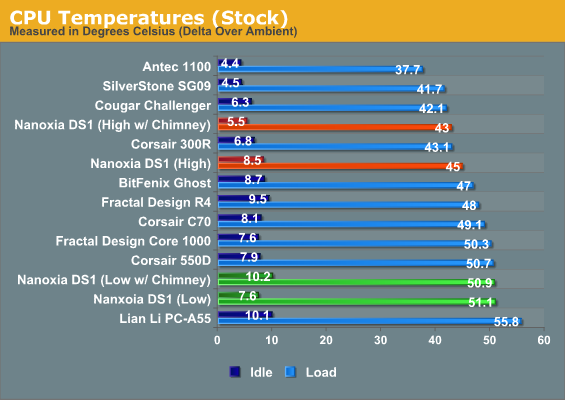
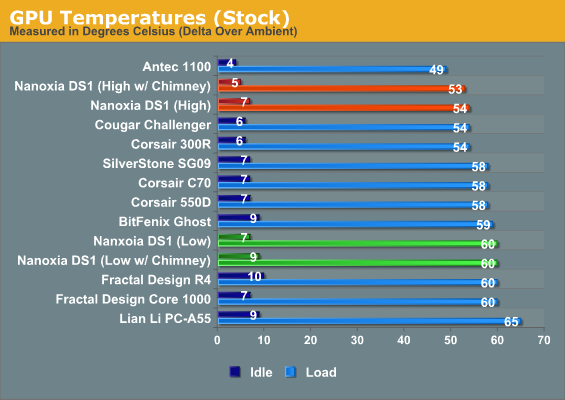
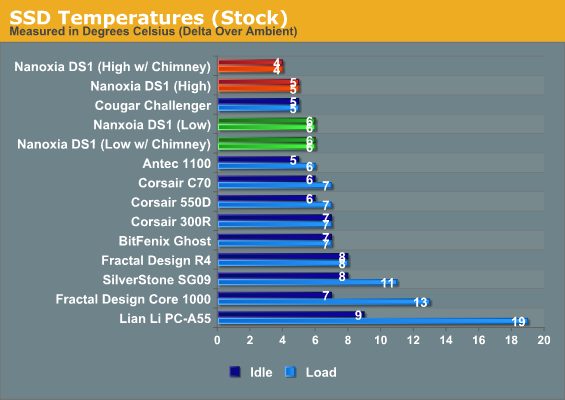
Temperatures with the fans turned all the way down are pretty poor, but if you max them out the DS1 easily beats the Corsair 550D and BitFenix Ghost. Pay special attention to how the DS1 ranks against the 550D, because if Nanoxia can get it out here at their targeted MSRP, they're going to be undercutting Corsair. What's really surprising, too, is that the DS1's load thermals with the fans all the way up are actually competitive with performance-oriented cases.
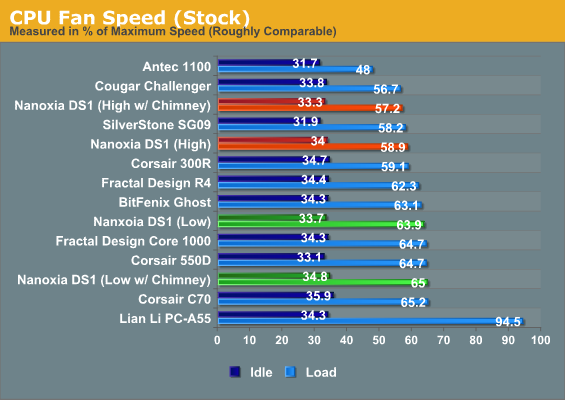
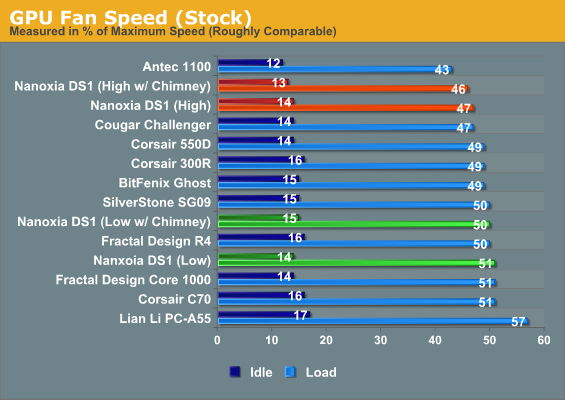
Fan speeds are reflective of the differences in thermal performance we saw. With the case fans on high, the Cooler Master Hyper 212 Evo and GTX 560 Ti's fans don't have to work nearly as hard.
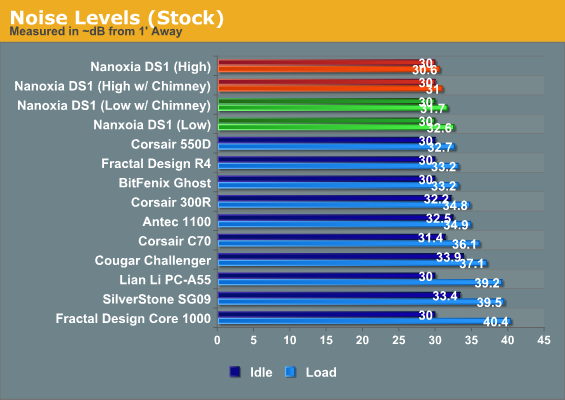
And here's the haymaker. Even with fans turned all the way up, the DS1 is still quieter than every other case. There's an audible difference between low and high that's unfortunately beneath the noise threshold of my sound meter; at low the case can really only be heard in a silent room in the dead of night. That said, the fans Nanoxia includes with the DS1 are very efficient, as is the cooling design of the case. More powerful (and louder) fans could probably easily shoot thermal performance to the top of the charts.
I'd also like to point out that the DS1's chimney has a very negligible effect on thermals and noise, which is both good and bad news depending on your perspective. It's good news because it means that keeping it open won't appreciably increase the noise the case produces, but bad news because it doesn't actually contribute in a meaningful way to case cooling.
Noise and Thermal Testing, Overclocked
Stock results for the Nanoxia Deep Silence 1 with the case fans set to low were admittedly pretty poor outside of the noise levels, and that made me nervous about testing it with the testbed overclocked. For what it's worth, the DS1 was able to run our overclocked testbed, but I wouldn't be comfortable with the low-90s temperatures that the CPU reached. You'll see, though, that if you let the fans stretch their legs a little, Nanoxia's design starts to come into its own again.
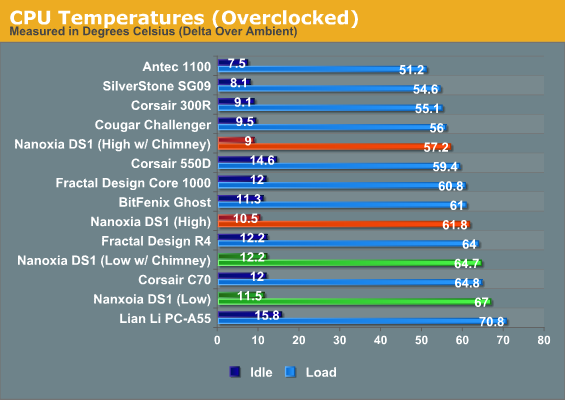
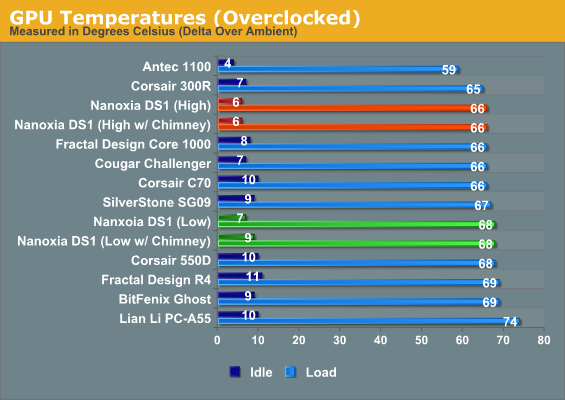
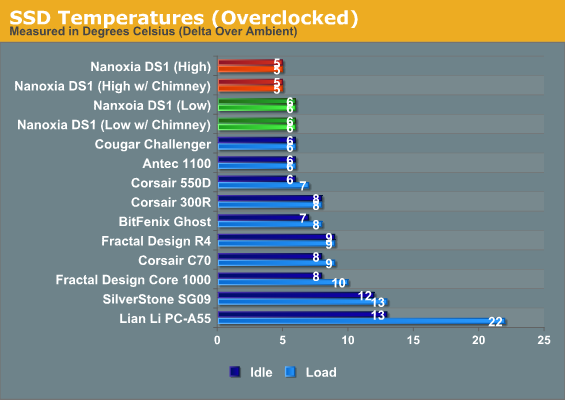
This is the first time keeping the chimney open has notably improved cooling performance, but the DS1 is starting to have trouble competing with the performance-oriented enclosures and is only able to tie the Ghost and 550D. Everything else runs reasonably cool, though.
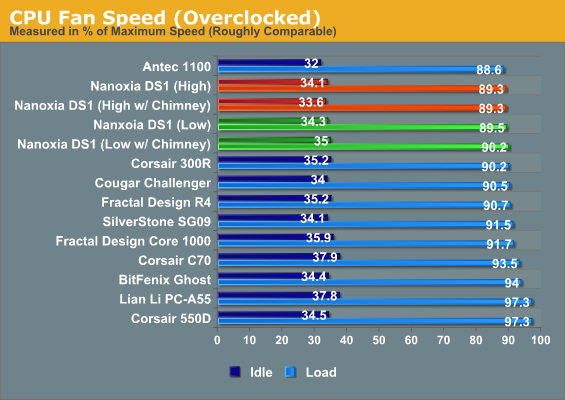
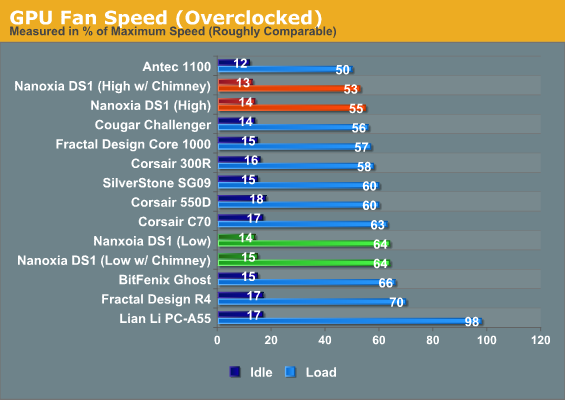
Fan speeds are much more competitive, though. The low fan setting has a hard time keeping up, but the high fan setting proves the case has a healthy amount of fight in it.
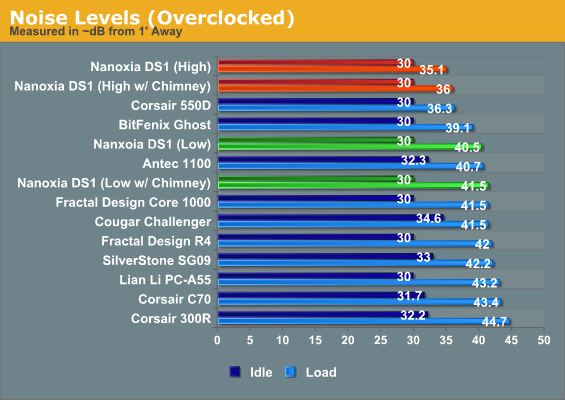
And then the other haymaker. Once again the DS1 is able to meet or beat the other silent cases while offering competitive if not superior performance. This isn't the coolest running case, but it's the quietest. Out of our high end cases, the only one that can produce comparable acoustic performance is NZXT's Phantom 820, a case that's going to cost at least twice as much.
Conclusion: We Need the Nanoxia Deep Silence 1
If it seems like I nitpicked the Nanoxia Deep Silence 1 in this review, it's only because the case itself is actually an incredibly strong design. It's not a perfect one, but Nanoxia did a heck of a lot right, and in many ways they're reminding me of another small company that was looking to break through in the US not too long ago: BitFenix. Together with BitFenix, Fractal Design, and Corsair, Nanoxia threatens to be part of a new wave of case designers that will shake the old stalwarts out of their complacency.
Before I start gushing about the DS1, it's only fair that I highlight some of the issues that the enclosure does have. As I said, it is by no means perfect. While Nanoxia assures me the I/O pop-up hinge has been fixed, that's not something I can readily test and prove (at least not until they send me another review unit) so I have to take them at their word. The old style mounting grooves for the side panels mean you'll be resting your body on the side of the case as you try to replace the panels, and it feels like the measurements for the motherboard tray seem ever so slightly off. Nanoxia's default fans are also obviously efficient, but because you have to push them to their fastest settings to get good thermal performance out of the case (great, even), that means there's very little room to grow without adding or changing fans. Finally, I'd like to see Nanoxia do a better job of matching the tone of the plastic fascia with the tone of the steel sides.
 With all that said, while I was testing the DS1, I was expecting it to run $150 at the least due to the sheer weight and durability of the materials used, and at that price I felt it would've been competitive. It's feature rich (I'm particularly bullish on the integrated analog fan controller), mostly user friendly, and offers solid performance in a very comfortable acoustic envelope. When they told me they were looking at a substantially lower price range, my first thought was "well, that's an editor's choice award right there." Thermal and acoustic performance meet or beat every other silent enclosure I've tested, build quality is good, and features are generous.
With all that said, while I was testing the DS1, I was expecting it to run $150 at the least due to the sheer weight and durability of the materials used, and at that price I felt it would've been competitive. It's feature rich (I'm particularly bullish on the integrated analog fan controller), mostly user friendly, and offers solid performance in a very comfortable acoustic envelope. When they told me they were looking at a substantially lower price range, my first thought was "well, that's an editor's choice award right there." Thermal and acoustic performance meet or beat every other silent enclosure I've tested, build quality is good, and features are generous.
BitFenix's Ghost and Fractal Design's Define R4 are both less expensive, but they don't perform as well either, and they're not as solid. Corsair's Obsidian 550D is more expensive and performs worse. The Deep Silence 1 could still use some refinement, but for the targeted price, it's going to be very tough for other manufacturers to beat. To me, that's Bronze Editor's Choice Award material. It doesn't quite live up to the hype, but it comes very close.

_thumb.jpg)
_thumb.jpg)
_thumb.jpg)
_thumb.jpg)
_thumb.jpg)
_thumb.jpg)
_thumb.jpg)
_thumb.jpg)
_thumb.jpg)
_thumb.jpg)
_thumb.jpg)
_thumb.jpg)






